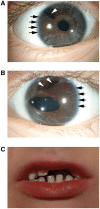Primary congenital and developmental glaucomas
- PMID: 28549150
- PMCID: PMC5886473
- DOI: 10.1093/hmg/ddx205
Primary congenital and developmental glaucomas
Abstract
Glaucoma is the leading cause of irreversible blindness worldwide. Although most glaucoma patients are elderly, congenital glaucoma and glaucomas of childhood are also important causes of visual disability. Primary congenital glaucoma (PCG) is isolated, non-syndromic glaucoma that occurs in the first three years of life and is a major cause of childhood blindness. Other early-onset glaucomas may arise secondary to developmental abnormalities, such as glaucomas that occur with aniridia or as part of Axenfeld-Rieger syndrome. Congenital and childhood glaucomas have strong genetic bases and disease-causing mutations have been discovered in several genes. Mutations in three genes (CYP1B1, LTBP2, TEK) have been reported in PCG patients. Axenfeld-Rieger syndrome is caused by mutations in PITX2 or FOXC1 and aniridia is caused by PAX6 mutations. This review discusses the roles of these genes in primary congenital glaucoma and glaucomas of childhood.
© The Author 2017. Published by Oxford University Press. All rights reserved. For Permissions, please email: journals.permissions@oup.com.
Figures


References
-
- Taylor R.H., Ainsworth J.R., Evans A.R., Levin A.V. (1999) The epidemiology of pediatric glaucoma: the Toronto experience. J. AAPOS, 3, 308–315. - PubMed
-
- Gilbert C.E., Canovas R., Kocksch d., Canovas R., Foster A. (1994) Causes of blindness and severe visual impairment in children in Chile. Dev. Med. Child Neurol., 36, 326–333. - PubMed
-
- Bejjani B.A., Stockton D.W., Lewis R.A., Tomey K.F., Dueker D.K., Jabak M., Astle W.F., Lupski J.R. (2000) Multiple CYP1B1 mutations and incomplete penetrance in an inbred population segregating primary congenital glaucoma suggest frequent de novo events and a dominant modifier locus. Hum. Mol. Genet., 9, 367–374. - PubMed
Publication types
MeSH terms
Substances
Supplementary concepts
Grants and funding
LinkOut - more resources
Full Text Sources
Other Literature Sources
Medical
Miscellaneous

